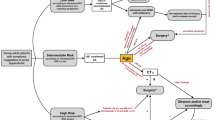Abstract
Post-tonsillectomy hemorrhage (PTH) is a relatively common and potentially life-threatening complication. The objective of this study was to examine the rate of PTH and identify risk factors. A retrospective cohort study was carried out including all tonsillectomies (430 patients) performed at Odense University Hospital (OUH) or Svendborg Hospital (SH), Denmark. PTH occurred in 52 patients (12.1%). Of the 180 patients treated with coblation technique, 41 (22.7%) had PTH. There were no fatal bleeding episodes. Multiple regression analysis resulted in three significant covariates: “Coblation as surgical technique” [relative risk (RR) = 5.3], “peritonsillar abscess as indication for surgery” (RR = 0.3) and “age equal to or above 15 years at the time of surgery” (RR = 5.4). It is concluded that patient age, PTA as indication for surgery and the use of coblation significantly affect the occurrence of PTH when coblation procedures are performed by non-experienced surgeons. We advise that implementation of coblation tonsillectomy is thoroughly planned with sufficient training of surgeons and continuous surveillance of results. If PTH rates comparable to “cold dissections tonsillectomy” cannot be reached intervention (learning or closing down of coblation tonsillectomy) has to be done.

Similar content being viewed by others
References
Lowe D, van der Meulen J (2004) Tonsillectomy technique as a risk factor for postoperative haemorrhage. Lancet 364:697–702
Polites N, Joniau S, Wabnitz D et al (2006) Postoperative pain following coblation tonsillectomy: randomized clinical trial. ANZ J Surg 76:226–229
Friedman M, LoSavio P, Ibrahim H, Ramakrishnan V (2003) Radiofrequency tonsil reduction: safety, morbidity, and efficacy. Laryngoscope 113:882–887
Mitic S, Tvinnereim M, Lie E, Saltyte BJ (2007) A pilot randomized controlled trial of coblation tonsillectomy versus dissection tonsillectomy with bipolar diathermy haemostasis. Clin Otolaryngol 32:261–267
Chang KW (2005) Randomized controlled trial of Coblation versus electrocautery tonsillectomy. Otolaryngol Head Neck Surg 132:273–280
Macassey EA, Baguley C, Dawes P, Gray A (2007) 15-year audit of post-tonsillectomy haemorrhage at Dunedin Hospital. ANZ J Surg 77:579–582
Windfuhr JP, Chen YS, Remmert S (2005) Hemorrhage following tonsillectomy and adenoidectomy in 15,218 patients. Otolaryngol Head Neck Surg 132:281–286
Myssiorek D, Alvi A (1996) Post-tonsillectomy hemorrhage: an assessment of risk factors. Int J Pediatr Otorhinolaryngol 37:35–43
Collison PJ, Mettler B (2000) Factors associated with post-tonsillectomy hemorrhage. Ear Nose Throat J 79:640–646
Alexander RJ, Kukreja R, Ford GR (2004) Secondary post-tonsillectomy haemorrhage and informed consent. J Laryngol Otol 118:937–940
Windfuhr JP, Chen YS (2002) Incidence of post-tonsillectomy hemorrhage in children and adults: a study of 4,848 patients. Ear Nose Throat J 81:626–632
Lehnerdt G, Senska K, Jahnke K, Fischer M (2005) Post-tonsillectomy haemorrhage: a retrospective comparison of abscess and elective tonsillectomy. Acta Otolaryngol 125:1312–1317
Kessler A, Lapinsky J, Segal S, Berkovitch M (2003) Bilateral peritonsillar abscesses: relief of upper airway obstruction by quinsy tonsillectomy. Isr Med Assoc J 5:126–127
Dunne AA, Granger O, Folz BJ et al (2003) Peritonsillar abscess: critical analysis of abscess tonsillectomy. Clin Otolaryngol Allied Sci 28:420–424
Windfuhr JP, Chen YS (2001) Immediate abscess tonsillectomy: a safe procedure? Auris Nasus Larynx 28:323–327
Klug TE, Ovesen T (2006) Post-tonsillectomy hemorrhage: incidence and risk factors. Ugeskr Laeger 168:2559–2562
Rachmanidou A, Robb PJ, Timms M (2005) A double-blinded randomized controlled trial of coblation versus conventional dissection tonsillectomy on postoperative symptoms. Clin Otolaryngol 30:477–478
Carney AS, Timms MS, Marnane CN et al (2008) Radiofrequency coblation for the resection of head and neck malignancies. Otolaryngol Head Neck Surg 138:81–85
Windfuhr JP, Deck JC, Remmert S (2005) Hemorrhage following coblation tonsillectomy. Ann Otol Rhinol Laryngol 114:749–756
Divi V, Benninger M (2005) Postoperative tonsillectomy bleed: coblation versus noncoblation. Laryngoscope 115:31–33
Javed F, Sadri M, Uddin J et al (2007) A completed audit cycle on post-tonsillectomy haemorrhage rate: coblation versus standard tonsillectomy. Acta Otolaryngol 127:300–304
Timms MS, Belloso A, Morar P, Robb PJ (2004) Increased post-operative haemorrhage seen in adult coblation tonsillectomy. J Laryngol Otol 118:247
Belloso A, Chidambaram A, Morar P, Timms MS (2003) Coblation tonsillectomy versus dissection tonsillectomy: postoperative hemorrhage. Laryngoscope 113:2010–2013
Acknowledgments
The authors thank consultant Michael Dahlstrøm, the Department of ENT Head and Neck Surgery, Svendborg Hospital, Denmark for valuable and informative contributions to this manuscript.
Conflict of interest statement
There are no conflicts of interest.
Author information
Authors and Affiliations
Corresponding author
Additional information
According to Danish law the regional ethical committee has been informed about the study.
Rights and permissions
About this article
Cite this article
Heidemann, C.H., Wallén, M., Aakesson, M. et al. Post-tonsillectomy hemorrhage: assessment of risk factors with special attention to introduction of coblation technique. Eur Arch Otorhinolaryngol 266, 1011–1015 (2009). https://doi.org/10.1007/s00405-008-0834-2
Received:
Accepted:
Published:
Issue Date:
DOI: https://doi.org/10.1007/s00405-008-0834-2




